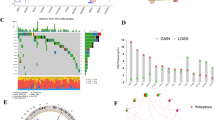Abstract
Purpose
The anti-inflammatory environment of glioma reduces the efficacy of immunotherapies. Therefore, it is vital to transform the immunosuppressive microenvironment of glioma into a pro-inflammatory environment. Sialic acid-binding immunoglobulin-type lectins (Siglecs) can serve as immune checkpoint targets that enhance the anti-tumor immune response. However, the roles of Siglecs in the glioma microenvironment are unknown. This study was conducted to identify targets to inhibit the anti-inflammatory environment to improve therapeutic outcomes in patients with glioma.
Methods
We analyzed the regulatory effect of prognosis-related Siglecs identified from data available in The Cancer Genome Atlas database (TCGA) and China Glioma Genome Atlas Data portal on the immunosuppressive microenvironment of glioma. The effects of prognosis-related Siglecs on the glioma microenvironment were investigated by determining the Pearson correlation coefficients of the Siglecs in transcriptome data from the TCGA database.
Results
Siglec-1, -9, -10, and -14 were closely associated with the prognosis of patients with glioma. The expression of these four Siglecs was significantly increased in the high-risk group and positively correlated with anti-inflammatory cytokine levels in the glioma microenvironment.
Conclusion
Our study provides insights into the effects of prognosis-related Siglecs in glioma immunotherapy, suggesting that targeted prognosis-related Siglecs can modify the microenvironment of glioma and improve the sensitivity of patients with glioma to immunotherapy.











Similar content being viewed by others
Abbreviations
- CTLA-4:
-
Cytotoxic T-lymphocyte-associated protein 4
- PD-1:
-
Programmed cell death protein 1
- NK:
-
Natural killer cells
- HIV:
-
Human immunodeficiency virus
- HBV:
-
Hepatitis B virus
References
Backer R et al (2010) Effective collaboration between marginal metallophilic macrophages and CD8+ dendritic cells in the generation of cytotoxic T cells. Proc Natl Acad Sci USA 107:216–221
Barkal AA et al (2019) CD24 signalling through macrophage Siglec-10 is a target for cancer immunotherapy. Nature 572:392–396
Bornhöfft KF et al (2018) Siglecs: a journey through the evolution of sialic acid-binding immunoglobulin-type lectins. Dev Comp Immunol 86:219–231
Cassetta L et al (2019) Deciphering myeloid-derived suppressor cells: isolation and markers in humans, mice and non-human primates. Cancer Immunol Immunother 68:687–697
Chen WC et al (2012) Antigen delivery to macrophages using liposomal nanoparticles targeting sialoadhesin/CD169. PLOS ONE 7:e39039
Chen X et al (2013) Induction of myelodysplasia by myeloid-derived suppressor cells. J Clin Invest 123:4595–4611
Chuntova P et al (2018) Genetically engineered T-cells for malignant glioma: overcoming the barriers to effective immunotherapy. Front Immunol 9:3062
Crane CA et al (2014) Immune evasion mediated by tumor-derived lactate dehydrogenase induction of NKG2D ligands on myeloid cells in glioblastoma patients. Proc Natl Acad Sci USA 111:12823–12828
Crocker PR et al (2007) Siglecs and their roles in the immune system. Nat Rev Immunol 7:255–266
DeAngelis LM (2001) Brain tumors. N Engl J Med 344:114–123
Delgado-López PD et al (2017) Diffuse low-grade glioma: a review on the new molecular classification, natural history and current management strategies. Clin Transl Oncol 19:931–944
Duan S et al (2020) Siglecs as immune cell checkpoints in disease. Annu Rev Immunol 38:365–395
Eisele G et al (2006) TGF-beta and metalloproteinases differentially suppress NKG2D ligand surface expression on malignant glioma cells. Brain 129:2416–2425
Fecci PE et al (2019) The current state of immunotherapy for gliomas: an eye toward the future. J Neurosurg 131:657–666
Hiruma Y et al (2013) Impaired osteoclast differentiation and function and mild osteopetrosis development in Siglec-15-deficient mice. Bone 53:87–93
Ho VK et al (2014) Changing incidence and improved survival of gliomas. Eur J Cancer 50:2309–2318
Hudak JE et al (2014) Glycocalyx engineering reveals a Siglec-based mechanism for NK cell immunoevasion. Nat Chem Biol 10:69–75
Jandus C et al (2014) Interactions between Siglec-7/9 receptors and ligands influence NK cell-dependent tumor immunosurveillance. J Clin Invest 124:1810–1820
Johnson DR et al (2012) Glioblastoma survival in the United States before and during the temozolomide era. J Neurooncol 107:359–364
Kamran N et al (2018) Current state and future prospects of immunotherapy for glioma. Immunotherapy 10:317–339
Klaas M et al (2012) Sialoadhesin in recognition of self and non-self. Semin Immunopathol 34:353–364
Klopfleisch R (2016) Macrophage reaction against biomaterials in the mouse model—phenotypes, functions and markers. Acta Biomater 43:3–13
Komohara Y et al (2017) Possible functions of CD169-positive sinus macrophages in lymph nodes in anti-tumor immune responses. Cancer Sci 108:290–295
Läubli H et al (2014) Engagement of myelomonocytic Siglecs by tumor-associated ligands modulates the innate immune response to cancer. Proc Natl Acad Sci USA 111:14211–14216
Lim M et al (2018) Current state of immunotherapy for glioblastoma. Nat Rev Clin Oncol 15:422–442
Lin CH et al (2021) Functions and therapeutic targets of Siglec-mediated infections, inflammations and cancers. J Formos Med Assoc 120:5–24
Lindau D et al (2013) The immunosuppressive tumour network: myeloid-derived suppressor cells, regulatory T cells and natural killer T cells. Immunology 138:105–115
Liu HF et al (2012) Altered polarization, morphology, and impaired innate immunity germane to resident peritoneal macrophages in mice with long-term type 2 diabetes. J Biomed Biotechnol 2012:867023
Liu G et al (2013) Modulation of macrophage activation and programming in immunity. J Cell Physiol 228:502–512
Louis DN et al (2007) The 2007 WHO classification of tumours of the central nervous system. Acta Neuropathol 114:97–109
Louis DN et al (2016) The 2016 world health organization classification of tumors of the central nervous system: a summary. Acta Neuropathol 131:803–820
Lübbers J et al (2018) Modulation of immune tolerance via siglec-sialic acid interactions. Front Immunol 9:2807
Macauley MS et al (2014) Siglec-mediated regulation of immune cell function in disease. Nat Rev Immunol 14:653–666
Mantovani A et al (2004) The chemokine system in diverse forms of macrophage activation and polarization. Trends Immunol 25:677–686
Martinez FO et al (2009) Alternative activation of macrophages: an immunologic functional perspective. Annu Rev Immunol 27:451–483
Mills CD et al (2000) M-1/M-2 macrophages and the Th1/Th2 paradigm. J Immunol 164:6166–6173
Motzer RJ et al (2020) Nivolumab versus everolimus in patients with advanced renal cell carcinoma: updated results with long-term follow-up of the randomized, open-label, phase 3 CheckMate 025 trial. Cancer 126:4156–4167
Murray PJ et al (2011) Protective and pathogenic functions of macrophage subsets. Nat Rev Immunol 11:723–737
Nduom EK et al (2015) Immunosuppressive mechanisms in glioblastoma. Neuro Oncol 17:9–14
Paulson JC et al (2012) Siglecs as sensors of self in innate and adaptive immune responses. Ann NY Acad Sci 1253:37–48
Pillai S et al (2012) Siglecs and immune regulation. Annu Rev Immunol 30:357–392
Rigamonti E et al (2014) Macrophage plasticity in skeletal muscle repair. Biomed Res Int 2014:560629
Robert C et al (2015) Pembrolizumab versus ipilimumab in advanced melanoma. N Engl J Med 372:2521–2532
Romagné F et al (2009) Preclinical characterization of 1–7F9, a novel human anti-KIR receptor therapeutic antibody that augments natural killer-mediated killing of tumor cells. Blood 114:2667–2677
Ruffin N et al (2019) Constitutive Siglec-1 expression confers susceptibility to HIV-1 infection of human dendritic cell precursors. Proc Natl Acad Sci USA 116:21685–21693
Santegoets KCM et al (2019) Expression profiling of immune inhibitory Siglecs and their ligands in patients with glioma. Cancer Immunol Immunother 68:937–949
Shao JY et al (2016) Siglec-7 defines a highly functional natural killer cell subset and inhibits cell-mediated activities. Scand J Immunol 84:182–190
Stanczak MA et al (2018) Self-associated molecular patterns mediate cancer immune evasion by engaging Siglecs on T cells. J Clin Invest 128:4912–4923
Umansky V et al (2019) Interactions among myeloid regulatory cells in cancer. Cancer Immunol Immunother 68:645–660
van den Bent MJ (2014) Practice changing mature results of RTOG study 9802: another positive PCV trial makes adjuvant chemotherapy part of standard of care in low-grade glioma. Neuro Oncol 16:1570–1574
van Dinther D et al (2018) Functional CD169 on macrophages mediates interaction with dendritic cells for CD8(+) T cell cross-priming. Cell Rep 22:1484–1495
Varchetta S et al (2013) Sialic acid-binding Ig-like lectin-7 interacts with HIV-1 gp120 and facilitates infection of CD4pos T cells and macrophages. Retrovirology 10:154
Varki A et al (2006) Siglecs–the major subfamily of I-type lectins. Glycobiology 16:1r–27r
Verschuere T et al (2011) Galectin-1 and immunotherapy for brain cancer. Expert Rev Neurother 11:533–543
Wang YC et al (2010) Notch signaling determines the M1 versus M2 polarization of macrophages in antitumor immune responses. Cancer Res 70:4840–4849
Wang J et al (2019) Siglec-15 as an immune suppressor and potential target for normalization cancer immunotherapy. Nat Med 25:656–666
Wielgat P et al (2021) The paired siglecs in brain tumours therapy: the immunomodulatory effect of dexamethasone and temozolomide in human glioma in vitro model. Int J Mol Sci 22:1791
Xiong YS et al (2014) Increased expression of Siglec-1 on peripheral blood monocytes and its role in mononuclear cell reactivity to autoantigen in rheumatoid arthritis. Rheumatology (Oxford) 53:250–259
Yang I et al (2011) Immune cell infiltrate differences in pilocytic astrocytoma and glioblastoma: evidence of distinct immunological microenvironments that reflect tumor biology. J Neurosurg 115:505–511
Yoshihara K et al (2013) Inferring tumour purity and stromal and immune cell admixture from expression data. Nat Commun 4:2612
Zeng Z et al (2017) Increased expression of Siglec-9 in chronic obstructive pulmonary disease. Sci Rep 7:10116
Zhao D et al (2018) Decreased Siglec-9 expression on natural killer cell subset associated with persistent HBV replication. Front Immunol 9:1124
Zhou Y et al (2020) Nivolumab plus ipilimumab versus pembrolizumab as chemotherapy-free, first-line treatment for PD-L1-positive non-small cell lung cancer. Clin Transl Med 10:107–115
Acknowledgements
Special thanks to Professor Dong Zhou for his guidance, Mr. Zhaohua Zeng for his help, and Dr. Yong Yang and Dr. Peng Wang for their financial support.
Funding
This work was financially supported by Natural Science Foundation of China (NO.81901250), High-level Hospital Construction Project of Guangdong Province of China (NO. DFJH201924) and Natural Science Foundation of Guangdong Province of China (NO.2018A0303130236).
Author information
Authors and Affiliations
Contributions
HL and JZ: extracted the data; RM: methodology, formal analysis, recourses; LZ and GL: software; YY: project administration, funding acquisition; PW: supervision; RM: writing-original draft. All authors reviewed the final manuscript.
Corresponding author
Ethics declarations
Conflict of interest
All authors have no conflicts of interest.
Additional information
Publisher's Note
Springer Nature remains neutral with regard to jurisdictional claims in published maps and institutional affiliations.
Supplementary Information
Below is the link to the electronic supplementary material.
432_2021_3762_MOESM2_ESM.pdf
Supplementary file2 (PDF 427 KB) Supplementary Fig. 2 Risk score analysis of Siglecs family four-gene prognostic model in CGGA glioma cohort. (A) Survival analysis according to risk score; (B) ROC analysis; (C) heat map; (D) risk score and (E)survival status of patients.
432_2021_3762_MOESM3_ESM.pdf
Supplementary file3 (PDF 323 KB) Supplementary Fig. 3 Risk score of glioma patients with different clinical characteristics (A-E). Multivariate Cox regression analyses of clinical characteristics and risk score associated with OS in the TCGA cohort(F). Multivariate Cox regression analyses of clinical characteristics and risk score associated with OS in the CGGA cohort(G).
432_2021_3762_MOESM4_ESM.pdf
Supplementary file4 (PDF 457 KB) Supplementary Fig. 4 Validation in CGGA. (A)The immune landscapes of high- and low-risk groups. (B) Comparison of immune cell infiltration between high- and low-risk groups.
432_2021_3762_MOESM5_ESM.pdf
Supplementary file5 (PDF 470 KB) Supplementary Fig.5 Analysis of immune cell infiltration. (A) The immune landscapes of IDH-mutant and IDH-wildtype groups. (B) Comparison of immune cell infiltration between IDH-mutant and IDH-wildtype groups.
432_2021_3762_MOESM6_ESM.pdf
Supplementary file6 (PDF 470 KB) Supplementary Fig.6 (A) The immune landscapes of 1p/19q-codel and 1p/19q non-codel groups. (B) Comparison of immune cell infiltration between 1p/19q-codel and 1p/19q non-codel groups.
Rights and permissions
About this article
Cite this article
Mao, R., Zhou, L., Yang, Y. et al. Regulation of prognosis-related Siglecs in the glioma microenvironment. J Cancer Res Clin Oncol 147, 3343–3357 (2021). https://doi.org/10.1007/s00432-021-03762-9
Received:
Accepted:
Published:
Issue Date:
DOI: https://doi.org/10.1007/s00432-021-03762-9




